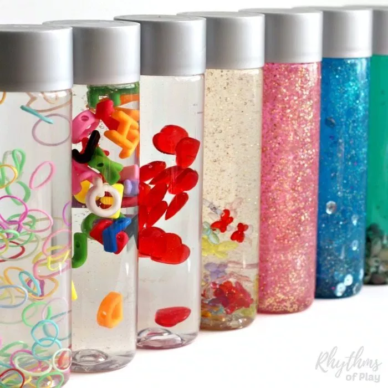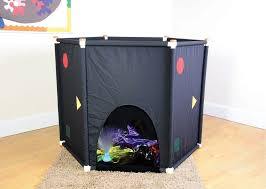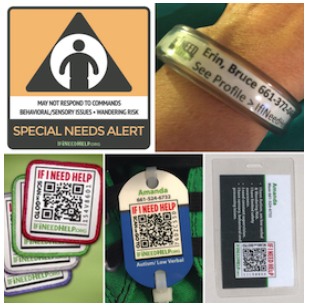Sensory Activities for Autistic Children
A Practical Guide to Home and Classroom Sensory Activities for Autistic Children
by LISA BELLUCK
Reposted with Permission from findreviews.com

Children are naturally playful and love exploring their senses
learning new things about the world around them through sight, touch, taste, smell, and sound. Whether a child is shaking a rattle or putting objects in their mouth, this is known as sensory play. It is an important development for children, especially those who have been diagnosed with autism spectrum disorder (ASD).

Children begin developing at an incredible rate between two and three years old, constantly
exploring and learning new things. Their senses play the most important factor into this. A toddler who touches a pot of boiling hot water, for example, will in the future associate “hot” with pain – but in the future, they may also recognize a pot of boiling water by the steam, and automatically know not to touch it.
Sensory experience is a vital part of brain development and the nervous system, so creating opportunities for children to engage their senses is paramount to their learning. Sensory activities thus stimulate the child’s core senses, building their awareness using textures, sounds, smells, etc.
For example, a child who plays with cups of water, whether they’re splashing the water around or transferring it between containers, is not only developing their sense of touch but learning about the movement of fluids.
With autism, some children are either hypersensitive or under-responsive to their senses, which falls under sensory processing disorder (SPD). This is when the brain finds it challenging to process and respond to the information being sent to it, so an overly-sensitive child may find certain sensory stimulation to be overwhelming.
A lightbulb can be too bright for them, or the simple act of brushing their hair can be painful because their brain sends mixed reactions to the sensory stimulations.Research has stated that over 75% of people with autism also have some type of sensory processing disorder. So for example, if an autistic child is overly sensitive to sounds, they may need to wear headphones to filter out a noisy environment.
Play Therapy UK
an international organization that specializes in sensory play for children, has released numerous findings based on their research:
- Between 74% and 83% of children receiving play therapy, delivered to PTUK/PTI standards, show a positive change.
- The more severe the problems the greater the percentage of children showing a positive change. 74% for those with slight/moderate problems, 83% for those with severe problems.
- Age also has an effect on improvement: Generally speaking the younger the child the greater the percentage of children showing a positive change: 80% at age 6 – 71% at age 12 – early help is the most effective.
- Girls show a higher improvement rate than boys, 79% compared to 73%.
Founding member of Play Therapy UK, Jeff Thomas, explained how PTUK utilizes sensory play with children diagnosed with ASD/SPD:
“Children choose what they want to do in the sessions from a wide range of creative arts therapeutic media. Sensory play forms a large part of session time (60%) through the use of clay, sand trays, water, messy play, drawing and painting, music and puppets – all of which have a sensory element. The Play Therapist communicates with the children using the same medium that the child has chosen, sharing the sensory aspects.”
Another organization, Sensory Trust, also provides sensory play to children with sensory processing disorders. An activity they use often for its multisensory approach, which yields the most benefits, is a simple game called “gofindit”, which is a nature-based scavenger card game.
The scavenger hunt game consists of 33 uniquely designed cards in a small drawstring bag which represent different sensations and sensory characteristics you can find outdoors in nature.
While therapy is highly beneficial to children diagnosed with ASD, there are many simple sensory-based activities you can do at home. We will outline some of the most popular.
Sensory Activities at Home

Coin rubbing
Take a few different coins, and cover them with a sheet of paper. Then have your child to rub over the top of the coin using crayons, which will create images of the coin’s surface. This activity can help to develop an ASD child’s hand-eye coordination skills.

Edible jewelry threading
Your ASD child will love creating their own colorful jewelry, especially if they can eat it afterwards. Candy bracelets can typically be found in supermarkets, so if you buy a bunch of those, then cut the strings and place all the candy in a jar, your child will have their own supply of candy beads to work with.

Put together a sensory activity collage
Because children with ASD can be overwhelmed by new textures and sensations, it helps to ease them into these things with a small collage. Glue items of various textures to a piece of cardboard, such as strips of carpet, pieces of cotton, aluminum foil, felt shapes, and other similar things. You can explain each object to your child, and introduce them to a wider range of textures without overwhelming them.

Ice cube painting
Acrylic paints can be poured into an ice tray, then frozen with wooden craft sticks. When the paints are frozen blocks, allow them to slightly thaw, then let your child swirl the melting paint blocks over a piece of paper. Your child will have fun creating beautiful designs, and it’s certainly less messy than working with liquid paints.

Sensory bottles
A fun project that can yield beautiful results, all you need is a few plastic bottles, a little food coloring, and some things like marbles or colorful plastic shapes. Fill the bottles with water, add a few drops of food coloring, and pour in the rest of the items, finally sealing the lid.
Oobleck
A fun substance that is neither a liquid nor a solid, oobleck is a non-Newtonian fluid that feels solid when pressed together, and oozes like a liquid when released. This is a fun activity and science lesson, and the oobleck properties should be quite amazing to a child with ASD. It is simply a mixture of 2 cups cornstarch, 1 cup of water, and optional food coloring. You can fine-tune the consistency with more food starch or water.

Memory by smell game
Fill a few small containers with fragrant ingredients, then ask your child to identify each smell. Studies show that children with ASD have an acute sensitivity to smell, so be careful not to use any overwhelming fragrances. Some good candidates are coffee beans, vanilla extract, sachets of lavender, etc.
Sensory Aids in the Classroom
It is important to work with your child’s teacher and school staff in creating a plan that benefits your child academically. In the U.S., your child may be given an IEP (individualized education plan), while in the U.K. it is known as SEN (special education needs). These programs are tailored to your child’s disorder, learning ability, and individual needs.
However, communication between parents and teachers is always important, for maximum benefit. There are several sensory play activities that can be applicable to the classroom, and it is worth mentioning these to your child’s teacher.
Classroom bean bag chairs: A simple bean bag chair can contribute to vestibular sensory needs (sense of balance), which is important for ASD children who are commonly prone to rocking themselves back and forth. A beanbag chair will help enable this activity better than a traditional school chair.

Sensory walls and panels: These can help children who require more visual input in class, and can be hung on the wall for children to run their hands over.
Conclusion
Sensory activities are highly beneficial to children with autism (and affiliated SPD), so there are just a few more things to remember.
- Consistency is Key: Children diagnosed with ASD may have difficulty in applying the things they’ve learned in one scenario to others. For example, an ASD child may learn a set of communication techniques at school but does not transition those communication techniques to the home. Consistency is key here, which involves communicating with the child’s teacher and that the child can more easily transfer positive habits between environments.
- Have a structured schedule: Children with ASD perform best under a highly-structured routine, as they can become easily confused, disoriented, and lash out when the world doesn’t make sense to them. The routine should include regular meal times, school, therapy, bedtime, and any other regular daily activities. Any disruptions to the routine should be kept to a minimal. If a routine disruption is unavoidable, it’s important to prepare the child well in advance.
- Use positive reinforcement: Children with ASD react positively to praise, especially in the long-term. It’s important to reward good behavior and be very specific about what exactly they’ve done correctly and earned praise for. This is highly useful when teaching an ASD child a new skill.
- Be aware of the child’s hypersensitivities, if any: Many children with ASD can be hypersensitive to specific senses, so it’s important to be aware of which sensory stimulations can trigger overwhelming stimulation, and avoid them.
If I NeedHelp makes wearable iD and offers a free Caregiver controlled special needs registry for our loved ones who may wander or need assistance in a critical moment.


